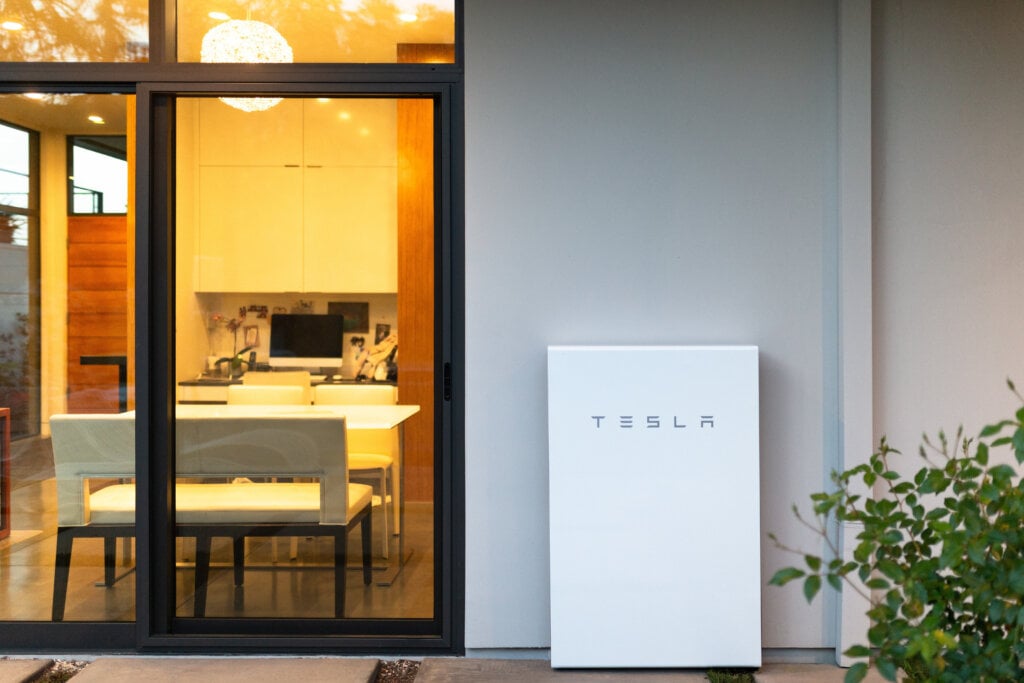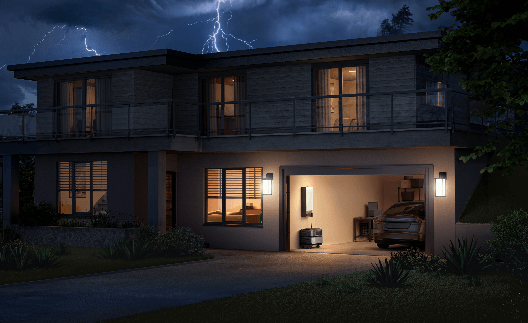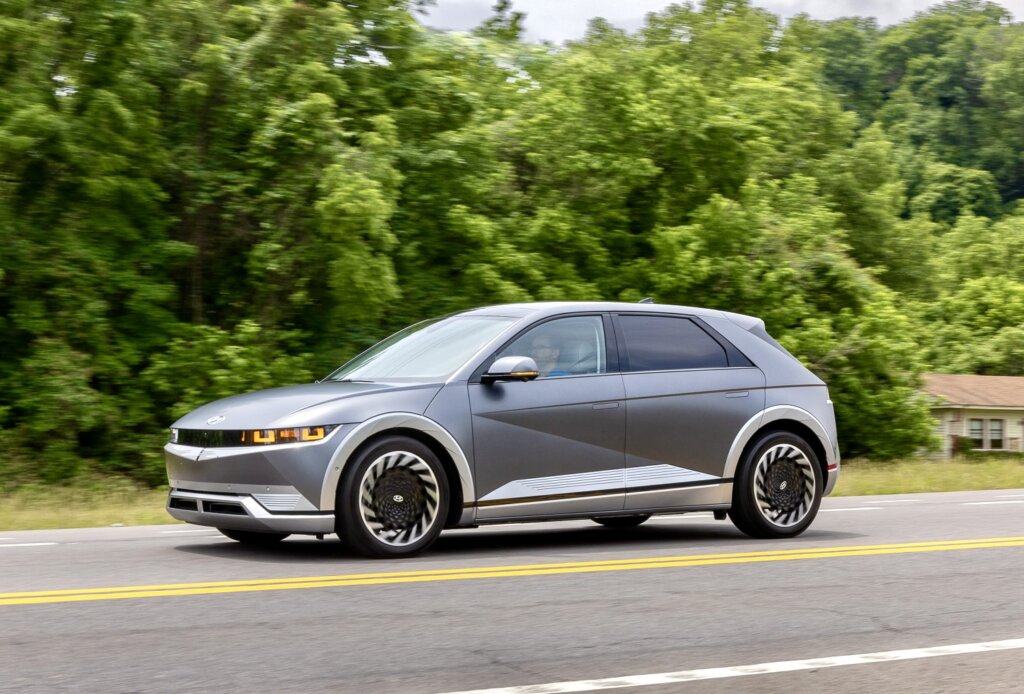How much is a backup power supply for your home?
Extreme weather is the new norm, so it’s smart to prepare for power outages. Battery backup power could be the solution—here’s how much it costs.
Advertisement
Extreme weather is the new norm, so it’s smart to prepare for power outages. Battery backup power could be the solution—here’s how much it costs.

If your home doesn’t have a backup power supply, it’s time to think about getting one. Across North America, and Canada in particular, power outages are becoming more and more common, driven in large part by extreme weather linked to climate change. During heat waves and cold snaps, home owners crank up their air conditioning or furnace, raising the risk of electricity shortages. And, of course, extreme weather disrupts power grids—and it’s happening with alarming frequency.
Severe storms can bring high winds and freezing rain, which can damage and knock down power lines. Floods, wildfires, hurricanes and tornadoes also cause lengthy power outages, lasting for hours or days. A prime example of extreme weather conditions here in Canada is the ice storm that gripped Quebec in April 2023. At the height of the resulting power outage, over one million residents were without power, and over 400,000 were still in the dark two days later. Only households with some form of backup power supply could keep their lights and furnaces on—which not only means staying comfortable, but also not losing money on spoiled food, and other inconveniences.
In the past, severe storms like this were so rare that they were called “100-year storms”—as in “once in a century.” But scientists now predict that by the end of the 21st century, 100-year storms could happen every year. According to Environment and Climate Change Canada, “When it comes to weather, exceptional has become the ordinary. Around the world, once-in-a-lifetime storms are now happening back-to-back. … We are no longer living in a period of climate stability but in a period of rapid climate change.”
In this article, I’ll look at different options for home backup power, including portable and standby generators fuelled by gas or propane, and portable power stations and whole-home systems powered by batteries.
| Gas, propane or natural gas–powered portable generator | Battery-powered portable power station | Gas-powered standby generator for whole home | Battery-powered whole-home system | |
| Capacity | 6.6 kWh to 108 kWh | 1 kWh to 25 kWh | 26 kWh | 1 kWh to 90 kWh |
| Cost including installation (if applicable) | $400 to $3,000 | $350 to $4,200 | $15,000 to $18,000 | $1,000 to $68,000+ |
When the power goes out, most Canadians have little choice but to find their flashlights and throw on an extra sweater (or find ways to keep cool) until it comes back on. To stay warm, some may rely on a secondary heat source such as a wood stove.
Home owners who want backup power can buy a gas-powered generator for about $400. Note that you need to keep fuel on hand, and generators this size can only back up 1,500 W (watts) of energy—that’s enough to power your furnace or a window AC unit for just a few hours. Another obvious drawback is that these generators can only be used outside, so most apartment and condo dwellers are out of luck.
As for a whole-house gas or propane standby generator that ties into your home’s circuit panel, it costs about $15,000 to $18,000 for an installed 26-kWh system (plus the cost of gas), according to Jamie Peterfi, an electrician and the owner of Keener Group Inc., an electrical contractor in St. Catharines, Ont. Home owners can buy smaller or larger systems as needed. (It’s also possible to rent a standby generator—check with your power company or an HVAC vendor.)
But apart from the cost, not to mention the higher carbon footprint of burning fossil fuels, outdoor generators don’t always fare well in harsh winter conditions. During the major storm that hit Fort Erie, Ont., in December 2022, 15,000 residents were left without power, some for as long as four days. Gale-force winds topped 100 kilometres per hour. Peterfi recalls that “the wind-driven rain and snow caused the air intake of generators to freeze up, producing an ice block that wouldn’t allow them to run very long.” So, many of those who shelled out all that money were still left in the dark.
What’s the alternative to gas and propane backup generators? Battery backup solutions. They’re not yet mainstream here in North America, but they’re an increasingly popular and often more affordable alternative to generators.
In the U.S., for instance, only 15% of consumers rely on battery backup solutions, but 51% would be interested in switching to a backup power solution that doesn’t rely on fossil fuels, according to a 2022 survey by Goal Zero, a company that makes both batteries and generators.
The adoption of backup batteries has been slow in Canada, but other parts of the world have embraced them, says Linda Nazar, PhD, FRS, a University of Waterloo professor and the Canada Research Chair in Solid State Energy Materials. She’s helping to spearhead battery research in Canada.
“There are areas in Japan where home batteries are more common and are used in conjunction with solar panels on their roofs,” she says, adding that she believes “we’re behind in electrochemical energy storage compared to countries such as Japan and Korea in part because they don’t have an independent source of oil and gas, so they’re forced to find more creative ways to meet their energy needs.”
Depending on your electricity needs, you could set up your home’s backup power using portable power stations or a whole-home battery backup system.
Thanks to widespread mobile phone and laptop usage, we already know the importance of having some form of portable backup power. Options range from handheld chargers or power banks that can fit inside a pocket or purse, to much larger, heavier power stations the size of a typewriter (for those Canadians who remember what that is) that can charge multiple devices at once.
For years, campers have used these portable power stations—priced from a few hundred to a few thousand dollars—in the great outdoors, turning to brands such as EcoFlow, Anker and Jackery. To recharge these power stations (also called power banks), you can either plug them in when the power is on or connect them with one or more solar panels (also available in portable sizes).
The same technology is used in entry-level whole-home backup solutions. Most of these portable power stations offer 1kWh to 4 kWh (kilowatt hours) of capacity, enough to keep everything from your sump pump, heating and air conditioning to your modem, lights and fridge running for a few hours.
At the other end of the spectrum, some home owners are opting for whole-home solutions with 10 to 40 kWh of capacity, or more. These systems automatically kick in during a power outage and can keep everything running for several hours or a few days.
A kilowatt hour (kWh) is a unit of measure for energy usage—it’s the energy delivered by one kilowatt (kW), or 1,000 watts (W), of power for one hour. The energy usage of devices and appliances is measured in kWh. For example, a 60 W ceiling fan running for six hours per day consumes about 11 kWh per month, or 132 kW per year. An energy-efficient 20-cubic-foot refrigerator running 24 hours a day uses 49 kWh per month. To calculate your home’s energy needs, use an appliance calculator, such as the ones from Hydro Quebec and NB Power.
Arguably the best-known company offering whole-home backup solutions is Tesla, with its 13.5-kWh Powerwall. However, it has a growing number of competitors in this category, including EcoFlow.
According to Peterfi, a minimum entry-level solution would be a battery with 3 kWh to 4 kWh—that’s enough juice to handle your basic needs if, for example, you lose electricity due to a fallen power line (which, on average, takes two to three hours to fix). Prices start at around $1,000 per 1 kWh of energy, give or take, depending on the manufacturer. For example, EcoFlow’s 3.6-kWh battery sells for $4,199, and Jackery’s 3-kWh battery retails for $3,999, as of late April 2024.
Bear in mind, though, that 3 kWh to 4 kWh is really an entry-level solution. If you heed the advice of the Government of Canada, which says that “you and your family should be prepared to cope on your own during a power outage for at least 72 hours,” then you might want to literally amp up your backup power along the lines of a Tesla Powerwall or an EcoFlow whole-house solution. Or, at the very least, a middle-ground solution.

As of late April 2024, a Tesla Powerwall costs $9,700 plus $1,200 for a Gateway, which connects the battery to your home’s existing electrical panel, monitors energy usage and automatically switches to backup power when there is an outage. Additional costs include delivery, installation and taxes. When all is said and done, Peterfi says, the final price tag could be about $15,000 to $20,000—comparable to the cost of an installed gas-powered generator.
The Powerwall is only available with a capacity of 13.5 kWh, but competitors have taken a more modular approach to energy storage. For example, a 3.6-kWh battery from EcoFlow, priced at $4,199, could be the starting point for a backup solution. If you need more power, you can bump up that wattage by connecting or daisy-chaining additional batteries (say, a 2-kWh model for $2,199).
EcoFlow also recently launched its Delta Pro Ultra Whole Home Backup Power solution in direct competition to Tesla. The Delta Pro Ultra’s $9,398 price includes a 6-kWh battery, an inverter (converts DC to AC power) and a smart home panel or transfer switch that literally transfers energy from your battery bank to whichever circuits on your panel you choose to back up. It’s a scalable solution (each additional 6-kWh battery costs $4,199) with a capacity that maxes out at 90 kWh. So, you can choose 6 kWh to 90 kWh of backup power storage—whatever fits your needs and budget.

You can plug your appliances and devices directly into these lower-wattage batteries (a.k.a. portable power stations). With some suppliers, you also have the option of adding a transfer switch similar to Tesla’s Gateway, but this requires installation by a qualified professional.
Entirely optional, but another consideration that directly ties in with a battery backup solution is whether or not to install solar panels to keep them charged. Yes, there’s an added cost, but if you go that route, it could dramatically reduce your month-to-month energy costs, in addition to helping you weather that next storm. According to Sunly, a Canadian solar panel installer, a household could save 60% to 90% on its electricity bills, depending on factors like location, price of electricity and more. Learn more about the cost of solar panels.
When it comes to choosing between batteries and generators, using electricity versus gas or propane isn’t the only difference. More key differences:
So, which backup solution is right for you and your home? It depends on what you want to power and for how long, and how much you’re prepared to pay.
A logical starting point is to inventory your energy consumption—how you heat, cool and light your home—and see what you can do to economically reduce it. So, not unlike preparing a financial budget based on how much you make and spend, look for cost-effective ways to reduce your energy usage (and your energy bill) so you’ll need less backup power to begin with.
For instance, LED lighting uses 75% less energy than incandescent lighting, so switching to LEDs will reduce both your energy bill and your need for backup energy. The upfront cost of LEDs is up to four times higher than that of incandescents, but LEDs also last up to 15 times longer. Compared to compact fluorescent bulbs (CFLs), LEDs cost twice as much but use half the energy and last three times longer.
Another key consideration is your existing source of heating and cooling, and whether you have a secondary source of heating, such as a wood or gas fireplace. The blower fan of a gas-powered furnace averages 400 W per hour, but variable-speed versions can go as low as 75 W an hour because they’re designed to operate at lower speeds when full power isn’t required. And that’s to heat your entire house. In contrast, electric baseboards for a single room average 250 W per foot, so if you have a six-foot baseboard, you’re looking at 1,500 W of juice every hour, just to heat a single room.
Once you’ve determined how much energy you need to keep the heat or cooling on, itemize what else you want to keep on. One essential, if you live somewhere with a high water table, is to set up sump pump backup power. But beyond that, you might be surprised how little power you need from a battery backup system. For instance, you could use complementary solutions such as battery-powered lights along with portable chargers and battery banks to keep your phones and computers running.
You can also get strategic with household appliances such as your fridge or freezer. For instance, the daily energy consumption of a fridge can range from as low as 350 to 600 W per day for an efficient Energy Star model to as high as 1,800 W per day for an older, less efficient model. At the higher end of this range, you could burn through a large percentage of your backup energy just powering your fridge.
However, as Peterfi observes, “In a power outage, your fridge is good to leave alone for eight to 10, sometimes 12 hours, as long as you’re not repeatedly opening it.” In other words, if you open your fridge or freezer door as little as possible, the appliance’s insulation will keep food cool for several hours—freeing up backup power for another household need. Groceries are expensive enough without having to throw food away.
Otherwise, you can opt for “load shedding,” which means not powering non-essentials, to further reduce your energy needs—and devote more backup battery power to things you do want to keep running.
Once you have a handle on your power needs, the next step is to add up your daily power requirements using an appliance calculator. So, for instance, your daily energy needs might be 8 kWh, but because you’ve decided to prioritize what to power during a storm, and perhaps you have a secondary heat source, you can temporarily cut your energy requirements to one-half or even one-third of what you would normally use.
“The short answer is ‘maybe,’” says Anne Marie Thomas, director of consumer and industry relations at the Insurance Bureau of Canada (IBC). “The long answer is: ‘It would have to be a hard-wired generator or backup battery system, not a portable one, and not every insurance company offers a discount.’”
“Hard-wired” means your backup power—whether gas-, propane- or battery-powered—is permanently attached to a home’s electrical panel. “It would kick in if you’re not home, whereas with a portable one, oftentimes you’d have to be there to get it going,” says Thomas.
Before investing in a backup power system, check with your insurance provider for any requirements. For example, only certain types of generators may qualify for a discount, and you might have to get professional installation. In any case, the insurance savings will likely be minimal. “My guess is low single digit,” says Thomas. “People typically install a generator for themselves, not for a discount.”
She suggests looking for other ways to lower your home insurance premiums. “Here are the things that would provide you with a discount: bundling home and auto insurance, having a centrally monitored fire and burglar alarm, and being mortgage-free.” Older adults may qualify for an age discount, and many professional and alumni associations negotiate discounts for their members, she adds. “And, obviously, shop around.” –Jaclyn Law
Here’s another possible source of battery backup power: an electric vehicle (EV). Certain manufacturers, including Hyundai, Kia, Nissan and Ford, make EVs with bi-directional charging capability. That means you can use your car’s or truck’s battery to charge other items. (Interesting fact: Tesla vehicles do not have bi-directional capabilities, in part, probably, because the company is also in the business of selling its Powerwall solution.) This bi-directional charging can be V2G (feeding energy from your vehicle to the power grid) or V2H (energy from your vehicle to your home).

EVs tend to be pricey, though. The starting price for a 2024 Hyundai Ioniq 5, for example, is nearly $60,000, plus taxes and fees. The federal government offers an incentive of up to $5,000 for EVs, with some provinces kicking in additional rebates. Certain provinces also offer rebates for EV chargers, which can cost a few hundred to a few thousand dollars. Read about EV and charger rebates.
Despite the steep cost of going this route, the upside is you can tap into the Ioniq 5’s impressive battery range of 58, 77 or 84 kWh (depending on the battery model)—which is several times the stored energy of a 13.5-kWh Tesla Powerwall—on top of having a vehicle to drive.
Considering the growing number of battery backup solutions out there, should you get one now?
“The right answer about whether people should be looking seriously at backup power solutions is ‘yes,’” says Nazar. “Climate change is here, and I think we all know that we’re going to have more chaotic climate change in the coming years.”
As for vehicle-to-home charging, she says, “I think that bi-directional charging functionality needs to become more commonplace. Only a limited number of EVs in North America offer it at present, but that is rapidly changing, and my guess is that V2H will become more mainstream in a few years.”
Nazar adds that California has already introduced legislation that, if passed, would mandate bi-directional charging as a standard for all new EVs beginning in 2027. With luck that impact will be felt here in Canada.
In light of the range of choices that await consumers already, and the fact that inclement weather and resulting power outages have become our new normal, it may not be long before home backup battery solutions are, as well.
Share this article Share on Facebook Share on Twitter Share on Linkedin Share on Reddit Share on Email
“Extreme weather is the new norm” Are you kidding me? Any climatologist (not in the pocket of politicians) will tell you that simply isn’y true.
You (and Moneysense) are obviously a hack of the federal government (and worried you won’t be monetized by them if you don’t spout their climate hysteria rhetoric).
BTW, anyone who uses fear to get 1) your eyes on their work 2) your vote or 3) your money, can’t be trusted.
Are there any recommended solutions for apartments?
To Mister Barber:
You mean 67 Tornadoes across just the American Mid-West at this time of year is normal and not extreme? Well you learn something new everyday! I am glad I live in Ontario Canada where we get extremely wet conditions (flooding) but not tornadoes, at least so far. Thanks for the update! Truth is always appreciated!